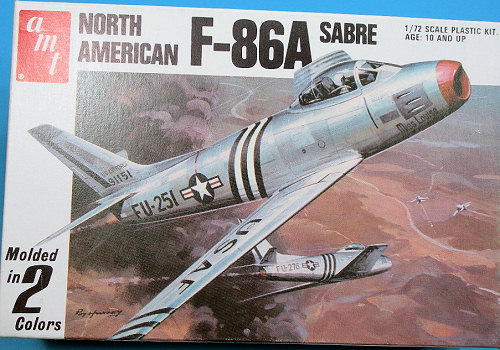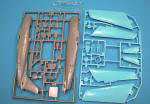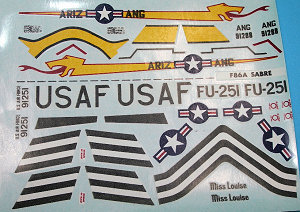
| KIT: | Matchbox 1/72 F-86A Sabre |
| KIT #: | PK-32 |
| PRICE: | $ Long Out of Production |
| DECALS: | Two Options |
| REVIEWER: | Victor Scheuerman |
| NOTES: | Only Injected F-86A in 1/72 |

| HISTORY |
If you buy into ‘if it looks right it must be right’; then the North American Sabre must be a perfect jet! This stunning aircraft made its operational debut over the Korean skies when it tangled with another jet that was remarkably similar in general configuration, just not as near as good looking; the famous MiG-15.
The Sabre platform was partially the result of German war time studies that showed that a swept wing would be a benefit in achieving a high speed. This information was used and the then proposed straight-wing XP-86 was built, but with the swept flying surfaces. Sabre 45-59597 flew for the first time on October 1, 1947 and was joined shortly after by the other two XP-86s.
North American’s Sabre would be dazzling success, being built in numerous day fighter versions (A,E,F) and then being modified and flown as both an all-weather fighter (D,K,L) and as a fighter bomber (H). It would also be the initial basis of the naval swept-wing Fury. In addition to North American production, it would be produced under license in Australia, Canada, Italy and Japan.
Since the Matchbox Sabre is the only A in 1/72 scale (that I am aware of), does it represent this initial version? Two external features should be readily apparent, the V-shaped windscreen addition and the smaller horizontal bulge on the tail.
| THE KIT |
 If
the box art did not give it away, then the two colours of trees with Made in
England should indicate its Matchbox heritage. While some Matchbox aircraft kits
have a combination of both raise and engraved panel lines, this Sabre A is
entirely engraved and actually not too bad. Now for those two signature A
configurations.
If
the box art did not give it away, then the two colours of trees with Made in
England should indicate its Matchbox heritage. While some Matchbox aircraft kits
have a combination of both raise and engraved panel lines, this Sabre A is
entirely engraved and actually not too bad. Now for those two signature A
configurations.
First, was the V shape addition in front of the flat panel of the windscreen offered? While Matchbox has a center panel that is definitely different from the norm, it is still flat. Different but not correct. The second item is that the horizontal tail surfaces were conventional in that they were fixed in location with separate elevators. This difference makes the attachment tail area bulge smaller then the later all-flying tail. In this regard Matchbox did well and now for the rest of the kit.
As one would expect, the kit cockpit is very basic with a nicely done pilot figure, a ejection seat that at least features the prominent head support, a totally odd wedge shaped firewall/instrument panel, and a ‘box shape’ for behind the seat that would look more at home in the swept-wing Fury. Another ‘oddity’ here, is the aft section of the canopy is molded as part of the fuselage in lieu of being part of the sliding canopy section. Good news is that the aft deck platform and instrument coaming are about correct in area and the one-piece canopy is quite clear.
Matchbox offers the option of
mounting the fuselage speed brakes open, but supplies no brake well detail.
Something that I really appreciate is that all the gear bays are framed in,
though devoid of any detail. Matchbox did a good job on the gear legs and tires
as the basic configuration is correct and the tires have some nice engraved
details. Howe ver, all the gear
doors require a good sanding or replacement with .010 card. One detail that is
missing from this kit that was almost always carried was the drop tanks.
ver, all the gear
doors require a good sanding or replacement with .010 card. One detail that is
missing from this kit that was almost always carried was the drop tanks.
As this was the AMT boxing, you get the Matchbox drawings but on different size paper and the detail colour notes are offered in the assembly sequence in lieu of the normal separate colour notes at the end. Again, the decals are the same for both boxings and feature two bare metal finished Sabres. First is a white and black striped A5 of the 4th FIW, based at Kimpo AFB, South Korea circa 1951 that features a red intake. The second and far more flamboyant scheme is a Sabre of the Arizona ANG and this is decorated with a yellow and red trimmed snake along the fuselage with further yellow trim on the front fuselage and vertical tail. Unlike the Matchbox kits that had these schemes illustrated in full colour on the back of the box, AMT has the same color plans but one on each box side.
| CONCLUSIONS |
This appears to be a rather nice kit externally that should look decent with some sanding and perhaps adding the missing wing tanks; or not. Even with the incorrect windscreen I think this one NEEDS to be built and added to my Canadair Sabre collection as the one and only Mk 1; stayed tuned!
July 2007
If you would like your product reviewed fairly and quickly by a site that has over 350,000 visitors a month, please contact me or see other details in the Note to Contributors.